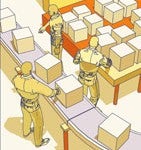 The United States is heading towards a resurgence of manufacturing that will reclaim from China a large piece of the market for making things and will start to reverse one of the most durable trends in international trade over the last 15 years, some analysts now say.
The United States is heading towards a resurgence of manufacturing that will reclaim from China a large piece of the market for making things and will start to reverse one of the most durable trends in international trade over the last 15 years, some analysts now say.
According to the Boston Consulting Group (BCG), a “manufacturing renaissance” in the U.S. is underway as the wage gap between the U.S. and China narrows dramatically. That gap is shrinking largely because manufacturing wages are rising far more quickly in China (17% annually over the next five years) than in the U.S. (3% for the same period) and also because the renminbi is set to appreciate gradually against the dollar in the coming years.
As that wage gap shrinks, some U.S. states will “become some of the cheapest locations for manufacturing in the developed world,” according to BCG, thanks in part also to flexible work rules and more government support. “We expect net labor costs for manufacturing in China and the U.S. to converge by around 2015,” BCG senior partner and managing director Hal Sirkin says.
Also contributing to the narrower wage gap is the continuing higher productivity of U.S. workers. Though the productivity of Chinese workers as risen tenfold since 1990, it remains only about two-thirds that of U.S. workers.
It’s not that the U.S. will become a cheaper location to manufacture versu China in absolute terms. But given that wages account for somewhere between 10% and 30% of total manufacturing costs, and given a much slimmer wage gap, the importance of wage costs in a given product’s cost will become far less important. Costs for other product inputs, meantime, are often very similar. What is likely is that the U.S. will gain significant advantages over the next five years when it comes to making certain kinds of products, such as more high-tech and individualize products requiring smaller productions runs, the BCG report suggests. China will likely maintain the advantage for large runs of standardized products.
Already, the U.S. has seen some manufacturers choose to return or remain in the U.S. Caterpillar, for example, decided to expand its hydraulic excavator manufacturing plant in Texas rather than in China, and the NCR Corp. in 2009 announced it was returning ATM production to Georgia, “in order to decrease the time to market, increase internal collaboration, and lower operating costs,” BCG noted. Last year Wham-O, the toymaker, brought half of its Frisbee and Hula Hoop production from China and Mexico to the U.S. What’s more, Ford and General Electric recently announced plans to build new plants in the U.S.
Wharton professors, meantime, offer some perspective on to this larger picture. While it is true that China looks likely to sink some because of its rising wages and currency, just how much the U.S. will benefit is less certain, says Marshall W. Meyer, professor of management at Wharton. “The U.S will never be a low-cost leader. China will cede this advantage to Indonesia, Vietnam, etc. However, when you factor supply chain risks into the equation — we have learned a lot from the March 11 earthquake and tsunami — then it becomes more plausible for manufacturing to return onshore.”
Wharton finance professor Franklin Allen agrees about the significance of supply chain issues as part of the mix. “While I do not think it is likely the U.S .will overtake China, I do think recent supply chain problems will lead to a revival in U.S. manufacturing.” He adds that “high-tech manufacturing is easier to control if done in the U.S. Dispersed manufacturing of high tech can create significant problems as the delays in the Boeing Dreamliner 787 illustrate.”
Allen recommends more caution regarding the value of the dollar going forward. “Predicting the dollar is very difficult. Given the problems in Europe, it could strengthen against the Euro. Also, predicting the exchange rate against the renminbi is not as easy as the U.S. government would seem to believe. They focus on the current account but the capital account is arguably more important. It is not clear what the balance of capital flows in and out of China would be if capital controls were gradually relaxed.”
Mauro Guillen, a Wharton management professor, thinks it is very difficult to generalize what will happen within individual industries. “There are some high value-added manufacturing tasks that continue to be competitive when performed in the U.S., including defense equipment, advanced instruments, robotics and the like. Some of them have increased recently due to the weaker dollar and efficiency enhancements, as in machinery, metals, automobile components and other areas.” But there are many other areas — textiles, clothing and furniture – that “are gone forever, even if the dollar remains weak.”
And while the lower dollar certainly helps boost U.S. competitiveness, “innovation is the best long-term fix,” says Meyer.



